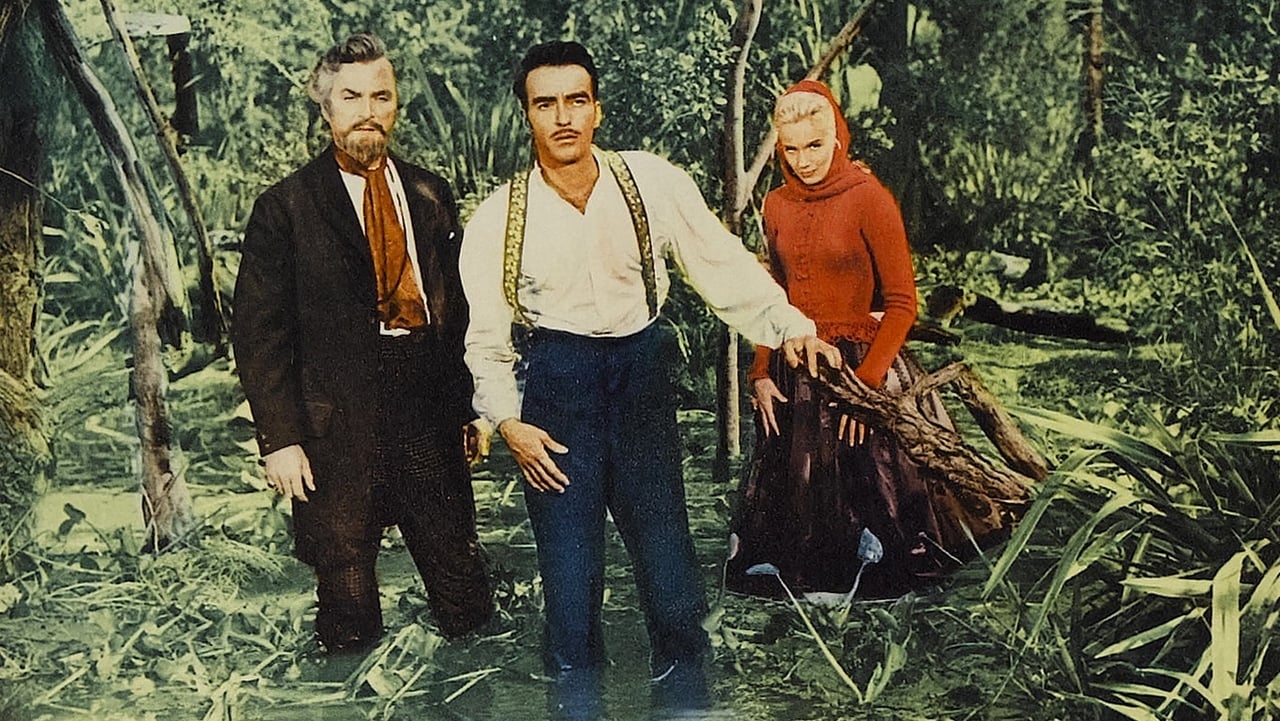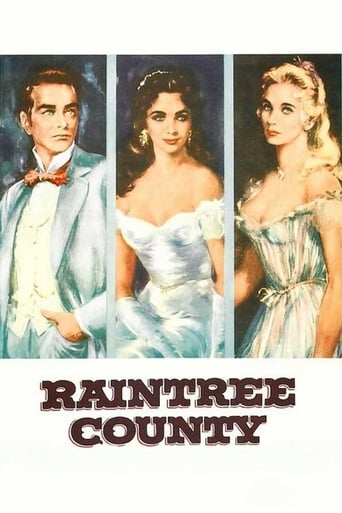GamerTab
That was an excellent one.
StunnaKrypto
Self-important, over-dramatic, uninspired.
Intcatinfo
A Masterpiece!
Stephanie
There is, somehow, an interesting story here, as well as some good acting. There are also some good scenes
themonster0
Many people have savaged this film over the years, but like 'Cat on a Hot Tin Roof' I have to watch 'Raintree County' every time it is on TCM.Considering the tragic accident that happened to Cliff during the filming, I am always in wonder that director Edward Dmytryk was able to make a film that holds together so well. The acting, cinematography and the writing are excellent. Even in the scenes where you can tell Cliff is in pain, his acting is great. Taylor, as always, is her excellent self.True, the film is long, but don't let that scare you. This film is worth the time to sit down and watch.
dougdoepke
Plot-- Before the Civil War, a pair of lovers marry and move from the North to the South where John finds out that new wife Susanna is haunted by a childhood trauma. Returning North they get caught up in the War, while Susanna becomes dysfunctional. What will John do, especially when lovelorn Neil (Saint) is still available.Oh my, I guess MGM had too big an investment not to release this swollen turkey. As I recall, it got a lot of hyped promotion in '57. For fans, like me, of the Taylor-Clift romantic pairing (A Place In The Sun, {1951}), this misguided sequel should be avoided like the plague. Taylor does her best in a part disjointed badly by a perforated script, while Clift struggles manfully following his traumatic road accident. Also undercutting the romantic theme is the absence of close-ups emphasizing the vital tender emotions. I suspect that was because of Clift's mid-filming disfigurement. Nonetheless, the first 2-hours of personal relationship is further pulled down by impersonal staging. And since so much of the film follows the romance, recovery is near impossible.The movie does come alive when Lee Marvin's blustery rough-neck comes on-screen. Clearly, he's on his way up the Hollywood ladder. But pity poor Eva Marie Saint of On The Waterfront (1954) whose sterling acting chops are almost totally wasted as the lonely heart in waiting. Where the movie does shine, as others point out, is in the visuals of costuming and massed army men. In short, the sort of production features big-budget MGM typically excelled at. I also like the effort at using the Raintree symbolism to bind the film into a poetic whole. Too bad, the script muddies that with sporadic development.Anyway, it's regrettable that such a prestige production got undercut by factors not entirely under studio control. I suspect there's a practical moral at work here, but I'm not sure what it is.
wc1996-428-366101
I feel really guilty because my partner of 40 years, who is an avid film collector, fished this tape out of his vast repository (5000 films) and set it up so I could watch it. Since his media center is in one room and our eating space in another (the kitchen)I was running back and forth between the movie and my breakfast lasagne waiting breathlessly for La Liz's entrance which I caught just in time between bites of food and of course she was ravishing as always and utterly the center of attention in every shot, everyone else fading into the woodwork - there will never be a star to equal her! But alas the script is a muddled mess and there is no question the studio (MGM)could not have found a worse writer than they did - I looked him up here and he did nothing to warrant being asked to adapt Raintree County from the book which he did along with the book's author. Right off the bat both the story and the central character (The Professor) are just plain silly with heartthrob Clift running off into a swamp in his Sunday Best for absolutely no reason and the professor running off with some man's wife. What all this has to do with the main storyline is anyone's guess, but after reading the synopsis of the story here I realized that poor MGM in its quest to film a sequel to GWTW failed miserably with this pathetic attempt. As the old saying says, you can't go home again!
Nazi_Fighter_David
Liz is a disturbed New Orleans belle with a vision that she's part black… She's the beautiful femme fatale to Eva Marie Saint's inevitable cowardly heroine… As in "A Place in the Sun," Liz is used as the symbol of a particular social class and a particular kind of woman… She sets her mark on an idealistic young man John Wickliff Shawnessy (Montgomery Clift) who's looking for the mythical rain tree that contains the secret of the meaning of life… Trapping him into marriage with the lie that she's pregnant, and then proceeding to lose her hold on her sanity, Susanna detains the good and helpless John for eight years… He is released, able to return to his magnificent dream and to his pure childhood sweetheart, only after tragic events… Retaining the essence of Ross Lockridge, Jr. best-seller, the movie states the equality of the unhappy romance with the Civil War: the personal drama is therefore a reflection of the nation's wounds… According to the top-heavy symbolism, Susanna Drake represents the South, corrupting and dragging down the North; she's the Body contaminating the poet's Soul… Taylor plays Susanna Drake's character with an intensity that exceeds all her earlier work… Montgomery Clift as the unlucky poet and Eva Marie Saint as his high school sweetheart and true love are on the remote side, but the scenes with Liz strike fire in a wonderfully brilliant way… With its battles and its formal balls, its magnificent riverboats and decayed mansions, its bordellos and madhouses, its childbirth and deathbed scenes, and its evacuation of Atlanta, Edward Dmytryk's "Raintree County," like its source, has undeniable epic dimension

